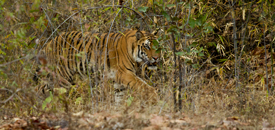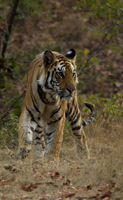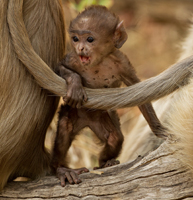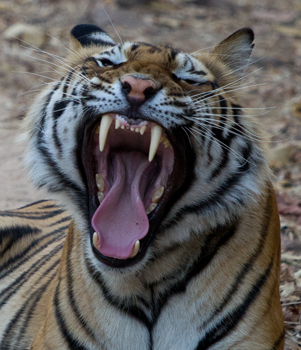India Tiger Photo Safaris
Trip Report Summary

25 tiger sightings, 2 leopards,
wild dogs, 2 sloth bears ...
for Trip One
54 tigers, 4 leopards, wild dogs, 4 sloth bears
... for Trip Two
Read our Complete Trip Journals,
day-to-day accounts of either or both trips
India Tiger Photo Safari, Trip One
Trip Two
Read our Brochure for 2012
Check out our Tiger book on Blurb
Tigers. The most endangered of the world's big cats, with no more than 7,000 and perhaps only 4,000 left in the wild. The most beautiful of the big cats, the most powerful, and the most charismatic. This year, 2011, marked our first visit to India in nearly twenty years, and our focus was on photographing tigers. The trips were officially scouting trips, but they functioned so smoothly the trips were little different from our usual photo tours. The first trip, as I write this, is finished, and it was a resounding success. Our first group had a total of 25 sightings as we visited three of India's best national parks, and I saw 13, with good photographs of at least 7 different tigers. On the second trip I saw 24 tigers myself, and our group had a total of 54, with one person seeing 32! We had several leopards, two great sloth bears, excellent Dhole or wild dog opportunities, and countless great birds.


Photographing India's wildlife, and its tigers, is far more difficult than photographing wildlife, and big cats, in East Africa. Tigers are forest dwellers, and invisible from a distance unless they're along a meadow edge. Nonetheless, we found tigers in a variety of locations, along pond edges, lying fully in the open on the park roads, crossing or walking down roads or game trails, and moving through thick brush. Some of the group's best shots (but certainly not all) were from elephant back, from Tiger Shows conducted when a tiger was reliably located.
 Two of my three favorite shoots occured in this way, but I also had tremendous luck from our jeep, where I filmed two different cats -- alone and later together -- as they lay beside or on the road, or walking through the forest parallel to our track. Others had wonderful luck from the jeeps, where we photograph just slightly higher than tiger-level. There are few thrills greater than having a tiger 'walking down the barrel' straight towards the lens, just feet away.
Two of my three favorite shoots occured in this way, but I also had tremendous luck from our jeep, where I filmed two different cats -- alone and later together -- as they lay beside or on the road, or walking through the forest parallel to our track. Others had wonderful luck from the jeeps, where we photograph just slightly higher than tiger-level. There are few thrills greater than having a tiger 'walking down the barrel' straight towards the lens, just feet away.
Of course, India's parks offered more than just tigers, and we photographed the Indian wild dog, or Dhole, several times, two leopards (though not very well), one great sloth bear, and all of the large herbivores. These included the world's largest bovine (cow-like mammals), the gaur, that resembles in some ways a sleek skinned bison, as well as our American elk look-alike, the sambar, and the lesser deer, like the spotted deer, and barasinga,or swamp deer. Two species of monkeys were common, the rhesus macaque and the large, blond langur monkey.
Shooting was challenging at times, as the Indian park system operates quite differently than what one is accustomed to in East Africa, and the quality of the drivers and guides varied greatly. Communication was difficult at times, and frustrating, but despite these headaches
we managed, and we certainly had great luck. I'm hoping that future trips will go more smoothly as we work out a system of good guides and drivers, as we've done in Africa, but even if the system stays as it is now, the system is workable and rewarding.
 Quite honestly we were a bit wary of returning to India as our previous experience, two decades ago, soured us from repeating the trip. Times have changed, and the difference was so great that we are already planning for our 2012 trips, and even more offerings in 2013. If you continue with my day-to-day trip reports, Trip One or Trip Two, you'll get a real feel for how a trip operates.
Quite honestly we were a bit wary of returning to India as our previous experience, two decades ago, soured us from repeating the trip. Times have changed, and the difference was so great that we are already planning for our 2012 trips, and even more offerings in 2013. If you continue with my day-to-day trip reports, Trip One or Trip Two, you'll get a real feel for how a trip operates.
Bottom line, photographing a tiger is a challenge, and getting a great image is a rewarding gift.
The light is magical, the landscape beautiful, the people wonderful, and the wildlife so different and fun to shoot, that both Mary and I are anxious to know more and India will be a permanent part of our future plans.
Learning more about the plight of the tiger, and the estimates as to India's cat population, and the world's, we're even more motivated. Not just to photograph a rare cat, but through our efforts in ecotourism, reenforcing the economic value tigers hold, and in this way perhaps help to insure the survival of the world's truly most beautiful big cat.

For more images, see our trip reports, Trip One or Trip Two.
India Tiger Photo Safaris
Trip Report Summary

25 tiger sightings, 2 leopards,
wild dogs, 2 sloth bears ...
for Trip One
54 tigers, 4 leopards, wild dogs, 4 sloth bears
... for Trip Two
Read our Complete Trip Journals,
day-to-day accounts of either or both trips
India Tiger Photo Safari, Trip One
Trip Two
Read our Brochure for 2012
Check out our Tiger book on Blurb
Tigers. The most endangered of the world's big cats, with no more than 7,000 and perhaps only 4,000 left in the wild. The most beautiful of the big cats, the most powerful, and the most charismatic. This year, 2011, marked our first visit to India in nearly twenty years, and our focus was on photographing tigers. The trips were officially scouting trips, but they functioned so smoothly the trips were little different from our usual photo tours. The first trip, as I write this, is finished, and it was a resounding success. Our first group had a total of 25 sightings as we visited three of India's best national parks, and I saw 13, with good photographs of at least 7 different tigers. On the second trip I saw 24 tigers myself, and our group had a total of 54, with one person seeing 32! We had several leopards, two great sloth bears, excellent Dhole or wild dog opportunities, and countless great birds.


Photographing India's wildlife, and its tigers, is far more difficult than photographing wildlife, and big cats, in East Africa. Tigers are forest dwellers, and invisible from a distance unless they're along a meadow edge. Nonetheless, we found tigers in a variety of locations, along pond edges, lying fully in the open on the park roads, crossing or walking down roads or game trails, and moving through thick brush. Some of the group's best shots (but certainly not all) were from elephant back, from Tiger Shows conducted when a tiger was reliably located.
 Two of my three favorite shoots occured in this way, but I also had tremendous luck from our jeep, where I filmed two different cats -- alone and later together -- as they lay beside or on the road, or walking through the forest parallel to our track. Others had wonderful luck from the jeeps, where we photograph just slightly higher than tiger-level. There are few thrills greater than having a tiger 'walking down the barrel' straight towards the lens, just feet away.
Two of my three favorite shoots occured in this way, but I also had tremendous luck from our jeep, where I filmed two different cats -- alone and later together -- as they lay beside or on the road, or walking through the forest parallel to our track. Others had wonderful luck from the jeeps, where we photograph just slightly higher than tiger-level. There are few thrills greater than having a tiger 'walking down the barrel' straight towards the lens, just feet away.
Of course, India's parks offered more than just tigers, and we photographed the Indian wild dog, or Dhole, several times, two leopards (though not very well), one great sloth bear, and all of the large herbivores. These included the world's largest bovine (cow-like mammals), the gaur, that resembles in some ways a sleek skinned bison, as well as our American elk look-alike, the sambar, and the lesser deer, like the spotted deer, and barasinga,or swamp deer. Two species of monkeys were common, the rhesus macaque and the large, blond langur monkey.
Shooting was challenging at times, as the Indian park system operates quite differently than what one is accustomed to in East Africa, and the quality of the drivers and guides varied greatly. Communication was difficult at times, and frustrating, but despite these headaches
we managed, and we certainly had great luck. I'm hoping that future trips will go more smoothly as we work out a system of good guides and drivers, as we've done in Africa, but even if the system stays as it is now, the system is workable and rewarding.
 Quite honestly we were a bit wary of returning to India as our previous experience, two decades ago, soured us from repeating the trip. Times have changed, and the difference was so great that we are already planning for our 2012 trips, and even more offerings in 2013. If you continue with my day-to-day trip reports, Trip One or Trip Two, you'll get a real feel for how a trip operates.
Quite honestly we were a bit wary of returning to India as our previous experience, two decades ago, soured us from repeating the trip. Times have changed, and the difference was so great that we are already planning for our 2012 trips, and even more offerings in 2013. If you continue with my day-to-day trip reports, Trip One or Trip Two, you'll get a real feel for how a trip operates.
Bottom line, photographing a tiger is a challenge, and getting a great image is a rewarding gift.
The light is magical, the landscape beautiful, the people wonderful, and the wildlife so different and fun to shoot, that both Mary and I are anxious to know more and India will be a permanent part of our future plans.
Learning more about the plight of the tiger, and the estimates as to India's cat population, and the world's, we're even more motivated. Not just to photograph a rare cat, but through our efforts in ecotourism, reenforcing the economic value tigers hold, and in this way perhaps help to insure the survival of the world's truly most beautiful big cat.

For more images, see our trip reports, Trip One or Trip Two.
India Tiger Photo Safaris
Trip Report Summary

25 tiger sightings, 2 leopards,
wild dogs, 2 sloth bears ...
for Trip One
54 tigers, 4 leopards, wild dogs, 4 sloth bears
... for Trip Two
Read our Complete Trip Journals,
day-to-day accounts of either or both trips
India Tiger Photo Safari, Trip One
Trip Two
Read our Brochure for 2012
Check out our Tiger book on Blurb
Tigers. The most endangered of the world's big cats, with no more than 7,000 and perhaps only 4,000 left in the wild. The most beautiful of the big cats, the most powerful, and the most charismatic. This year, 2011, marked our first visit to India in nearly twenty years, and our focus was on photographing tigers. The trips were officially scouting trips, but they functioned so smoothly the trips were little different from our usual photo tours. The first trip, as I write this, is finished, and it was a resounding success. Our first group had a total of 25 sightings as we visited three of India's best national parks, and I saw 13, with good photographs of at least 7 different tigers. On the second trip I saw 24 tigers myself, and our group had a total of 54, with one person seeing 32! We had several leopards, two great sloth bears, excellent Dhole or wild dog opportunities, and countless great birds.


Photographing India's wildlife, and its tigers, is far more difficult than photographing wildlife, and big cats, in East Africa. Tigers are forest dwellers, and invisible from a distance unless they're along a meadow edge. Nonetheless, we found tigers in a variety of locations, along pond edges, lying fully in the open on the park roads, crossing or walking down roads or game trails, and moving through thick brush. Some of the group's best shots (but certainly not all) were from elephant back, from Tiger Shows conducted when a tiger was reliably located.
 Two of my three favorite shoots occured in this way, but I also had tremendous luck from our jeep, where I filmed two different cats -- alone and later together -- as they lay beside or on the road, or walking through the forest parallel to our track. Others had wonderful luck from the jeeps, where we photograph just slightly higher than tiger-level. There are few thrills greater than having a tiger 'walking down the barrel' straight towards the lens, just feet away.
Two of my three favorite shoots occured in this way, but I also had tremendous luck from our jeep, where I filmed two different cats -- alone and later together -- as they lay beside or on the road, or walking through the forest parallel to our track. Others had wonderful luck from the jeeps, where we photograph just slightly higher than tiger-level. There are few thrills greater than having a tiger 'walking down the barrel' straight towards the lens, just feet away.
Of course, India's parks offered more than just tigers, and we photographed the Indian wild dog, or Dhole, several times, two leopards (though not very well), one great sloth bear, and all of the large herbivores. These included the world's largest bovine (cow-like mammals), the gaur, that resembles in some ways a sleek skinned bison, as well as our American elk look-alike, the sambar, and the lesser deer, like the spotted deer, and barasinga,or swamp deer. Two species of monkeys were common, the rhesus macaque and the large, blond langur monkey.
Shooting was challenging at times, as the Indian park system operates quite differently than what one is accustomed to in East Africa, and the quality of the drivers and guides varied greatly. Communication was difficult at times, and frustrating, but despite these headaches
we managed, and we certainly had great luck. I'm hoping that future trips will go more smoothly as we work out a system of good guides and drivers, as we've done in Africa, but even if the system stays as it is now, the system is workable and rewarding.
 Quite honestly we were a bit wary of returning to India as our previous experience, two decades ago, soured us from repeating the trip. Times have changed, and the difference was so great that we are already planning for our 2012 trips, and even more offerings in 2013. If you continue with my day-to-day trip reports, Trip One or Trip Two, you'll get a real feel for how a trip operates.
Quite honestly we were a bit wary of returning to India as our previous experience, two decades ago, soured us from repeating the trip. Times have changed, and the difference was so great that we are already planning for our 2012 trips, and even more offerings in 2013. If you continue with my day-to-day trip reports, Trip One or Trip Two, you'll get a real feel for how a trip operates.
Bottom line, photographing a tiger is a challenge, and getting a great image is a rewarding gift.
The light is magical, the landscape beautiful, the people wonderful, and the wildlife so different and fun to shoot, that both Mary and I are anxious to know more and India will be a permanent part of our future plans.
Learning more about the plight of the tiger, and the estimates as to India's cat population, and the world's, we're even more motivated. Not just to photograph a rare cat, but through our efforts in ecotourism, reenforcing the economic value tigers hold, and in this way perhaps help to insure the survival of the world's truly most beautiful big cat.

For more images, see our trip reports, Trip One or Trip Two.
India Tiger Photo Safaris
Trip Report Summary

25 tiger sightings, 2 leopards,
wild dogs, 2 sloth bears ...
for Trip One
54 tigers, 4 leopards, wild dogs, 4 sloth bears
... for Trip Two
Read our Complete Trip Journals,
day-to-day accounts of either or both trips
India Tiger Photo Safari, Trip One
Trip Two
Read our Brochure for 2012
Check out our Tiger book on Blurb
Tigers. The most endangered of the world's big cats, with no more than 7,000 and perhaps only 4,000 left in the wild. The most beautiful of the big cats, the most powerful, and the most charismatic. This year, 2011, marked our first visit to India in nearly twenty years, and our focus was on photographing tigers. The trips were officially scouting trips, but they functioned so smoothly the trips were little different from our usual photo tours. The first trip, as I write this, is finished, and it was a resounding success. Our first group had a total of 25 sightings as we visited three of India's best national parks, and I saw 13, with good photographs of at least 7 different tigers. On the second trip I saw 24 tigers myself, and our group had a total of 54, with one person seeing 32! We had several leopards, two great sloth bears, excellent Dhole or wild dog opportunities, and countless great birds.


Photographing India's wildlife, and its tigers, is far more difficult than photographing wildlife, and big cats, in East Africa. Tigers are forest dwellers, and invisible from a distance unless they're along a meadow edge. Nonetheless, we found tigers in a variety of locations, along pond edges, lying fully in the open on the park roads, crossing or walking down roads or game trails, and moving through thick brush. Some of the group's best shots (but certainly not all) were from elephant back, from Tiger Shows conducted when a tiger was reliably located.
 Two of my three favorite shoots occured in this way, but I also had tremendous luck from our jeep, where I filmed two different cats -- alone and later together -- as they lay beside or on the road, or walking through the forest parallel to our track. Others had wonderful luck from the jeeps, where we photograph just slightly higher than tiger-level. There are few thrills greater than having a tiger 'walking down the barrel' straight towards the lens, just feet away.
Two of my three favorite shoots occured in this way, but I also had tremendous luck from our jeep, where I filmed two different cats -- alone and later together -- as they lay beside or on the road, or walking through the forest parallel to our track. Others had wonderful luck from the jeeps, where we photograph just slightly higher than tiger-level. There are few thrills greater than having a tiger 'walking down the barrel' straight towards the lens, just feet away.
Of course, India's parks offered more than just tigers, and we photographed the Indian wild dog, or Dhole, several times, two leopards (though not very well), one great sloth bear, and all of the large herbivores. These included the world's largest bovine (cow-like mammals), the gaur, that resembles in some ways a sleek skinned bison, as well as our American elk look-alike, the sambar, and the lesser deer, like the spotted deer, and barasinga,or swamp deer. Two species of monkeys were common, the rhesus macaque and the large, blond langur monkey.
Shooting was challenging at times, as the Indian park system operates quite differently than what one is accustomed to in East Africa, and the quality of the drivers and guides varied greatly. Communication was difficult at times, and frustrating, but despite these headaches
we managed, and we certainly had great luck. I'm hoping that future trips will go more smoothly as we work out a system of good guides and drivers, as we've done in Africa, but even if the system stays as it is now, the system is workable and rewarding.
 Quite honestly we were a bit wary of returning to India as our previous experience, two decades ago, soured us from repeating the trip. Times have changed, and the difference was so great that we are already planning for our 2012 trips, and even more offerings in 2013. If you continue with my day-to-day trip reports, Trip One or Trip Two, you'll get a real feel for how a trip operates.
Quite honestly we were a bit wary of returning to India as our previous experience, two decades ago, soured us from repeating the trip. Times have changed, and the difference was so great that we are already planning for our 2012 trips, and even more offerings in 2013. If you continue with my day-to-day trip reports, Trip One or Trip Two, you'll get a real feel for how a trip operates.
Bottom line, photographing a tiger is a challenge, and getting a great image is a rewarding gift.
The light is magical, the landscape beautiful, the people wonderful, and the wildlife so different and fun to shoot, that both Mary and I are anxious to know more and India will be a permanent part of our future plans.
Learning more about the plight of the tiger, and the estimates as to India's cat population, and the world's, we're even more motivated. Not just to photograph a rare cat, but through our efforts in ecotourism, reenforcing the economic value tigers hold, and in this way perhaps help to insure the survival of the world's truly most beautiful big cat.

For more images, see our trip reports, Trip One or Trip Two.


